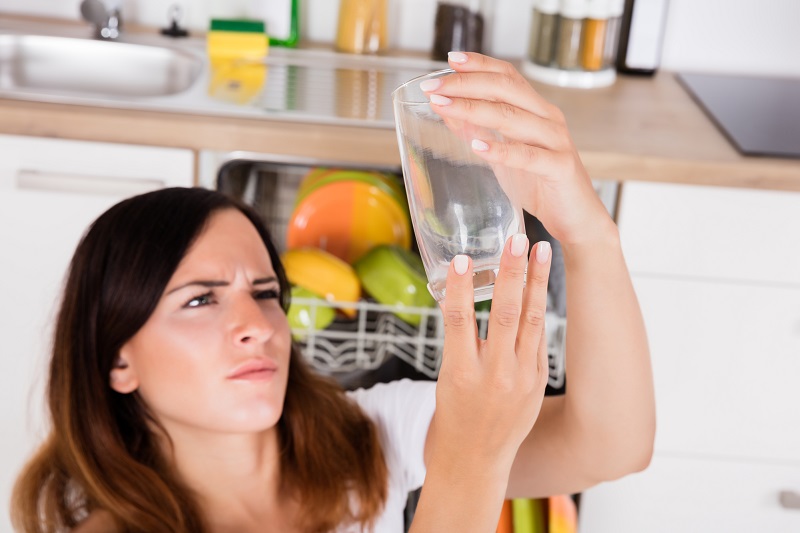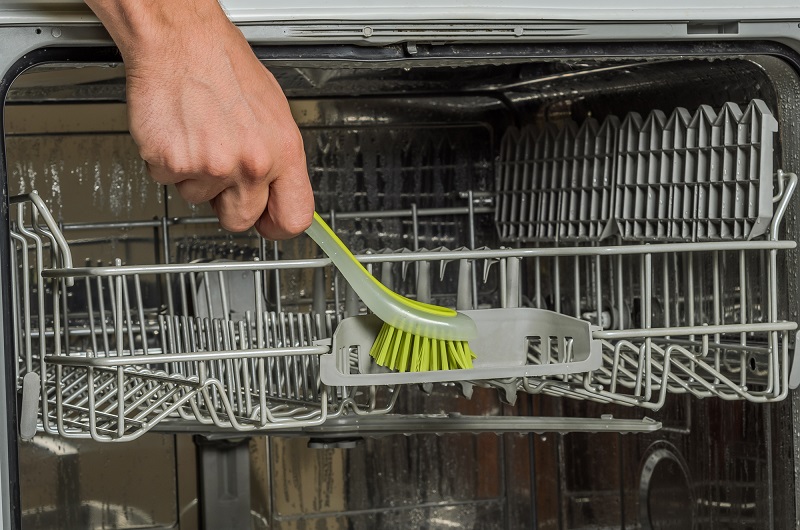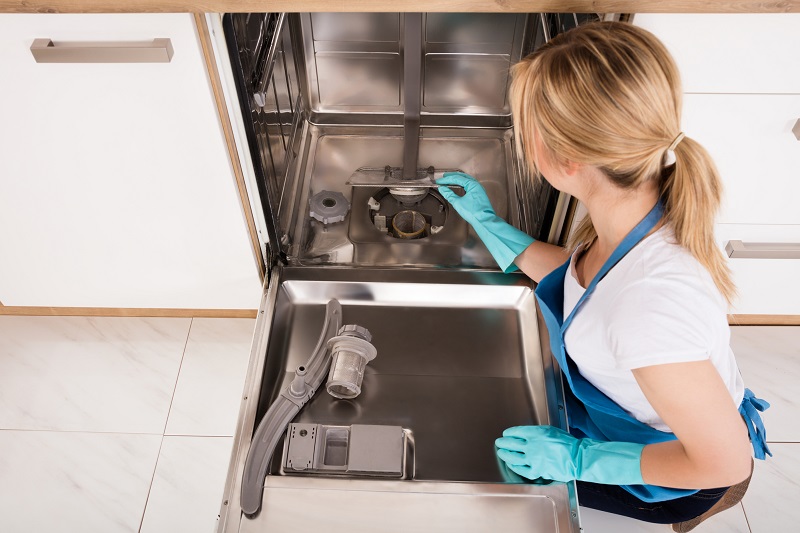Cleaning a dishwasher? Yea, it may sound dumb, but it’s really a chore you should consider. You might be in for a surprise to come across a lot of dirt and grime that has accumulated over time, rendering the machine less effective.
And if a longer lifespan is not enough of an incentive, remember that a dirty dishwasher is nothing short of a breeding ground for bacteria which could in turn lead to diseases in your household.
Quick Tips to Keep Your Dishwasher Clean
Before we get to our detailed instructions on how to clean your dishwasher let’s discuss some things you can do on a daily basis. Here are a few tips to ensure that your dishwasher does not get too dirty before your next cleaning day:
- Always rinse your dishes before throwing them into the dishwasher. This ensures that not too much food settles on the filter as that is the main source of dishwasher odors. We strongly recommend this even for the newer machines that say you don’t have to. It’s just a good habit.
- Always leave the dishwasher’s door slightly open whenever it’s idle. This dries out any moisture left behind after a washing cycle and allows the circulation of air into the dishwasher. A moist dishwasher could result in the accumulation and festering of grossness within it.
- Get in the habit of removing any leftover food particles in the dishwasher after every wash cycle to prevent any dirt buildup. All you need to do is remove the bottom rack and use a paper towel to collect the food remnants.
Directions on How to Clean a Dishwasher

A detailed step by step procedure on how to clean your dishwasher will be given depending on the type of cleaning to ensure that you are able to carry out each individual type of cleaning when the time is right without a hustle. But before we get to that, we need to know what you’ll need.
Necessary Tools and Materials
Since the cleaning methods below share most of the same tools and materials, a compiled list has been provided below to prevent repetition. All you will need is to refer to each method for the respective tools and materials. They include:
- Clean, soft cloths (or sponges) for cleaning inside
- Dish soap and warm water
- Good appliance polish or stainless steel cleaner
- Basin, bucket or any container to hold soapy water
- Distilled white vinegar or a dishwasher cleaning tablet
- Baking soda
- Microfiber cloth for cleaning outside of dishwasher
- Toothbrush or dishwasher brush
- Dishwasher safe glass or bowl
- Spray bottle
- Hydrogen peroxide
- Rubber cleaning gloves (we recommend these reusable rubber gloves from Mamison)
- Toothpick or flexible wire
- Parchment paper
Regular Cleaning of Your Dishwasher

Regular cleaning is more or less the type of cleaning done when necessary and mostly involves cleaning the dishwasher’s exterior. It can be done after every wash cycle or whenever the dishwasher’s exterior looks dirty.
You will notice that dust particles, food stains and fingerprints will be a constant existence on your dishwasher’s exterior and will generally give it a grimy and dirty appearance that cannot be ignored. Regular cleaning therefore serves to target such stains and largely depends on the material that the dishwasher is made from.
Step One: Gather All the Necessary Tools and Materials
This method of cleaning is quite fast and easy and all you need are a few tools and materials. Gather all the materials mentioned in each step and get cleaning. Now put on that pair of gloves.
Step Two: Clean the Dishwasher’s Exterior
It’s now time to start cleaning the dishwasher. Take the clean and soft cloth and immerse it in the water then add some soap. Once you have done so, thoroughly squeeze out the water to the extent that the cloth is left feeling only slightly damp. Take the slightly damp cloth and wipe the exterior of the dishwasher ensuring that you remove any and all smudges and stains.
Step Three: Polish or Wax the Dishwasher
It’s now time to give your dishwasher a polished look by getting rid of any watermarks and streaks left behind by the damp cloth. For a stainless steel dishwasher, all you need is your preferred type of stainless steel cleaner and a dry microfiber cloth. The right type of stainless steel cleaner not only polishes the dishwasher without leaving behind any streaks but also has active ingredients that acts as a dust and smudge repellent.
For any other dishwasher that does not have a stainless steel finish, use appliance wax or polish with a the dry cloth to give the dishwasher a polished look. Now step back and watch how sparkly and polished the dishwasher looks. Good as new!
Tip: Do not clean the exterior of your dishwasher with a scouring pad or any type of powered cleaner as it could result in scratches which take away from the beauty of the dishwasher’s exterior. For a stainless steel dishwasher, avoid any appliance polish, wax, bleach or products that have chlorine as an active ingredient.
Dishwasher Routine Monthly Cleaning

If you are wondering why you need to adopt the routine of cleaning your dishwasher every month then this reason is bound to have you setting a monthly reminder on your phone and committing a specified day to clean your dishwasher. You are advised to routinely clean your dishwasher every month as it eliminates the constant need for a far more aggressive and thorough clean.
Step One: Gather All the Necessary Tools and Materials
All you need is to gather all the materials listed in each step while cross referring to the ones mentioned above. Put on the pair of rubber gloves and get ready to start.
Step Two: Remove the Utensil Holders, Filter and Dishwasher Racks
This is similar to clearing a workstation to remove anything that will stand in the way of the cleaning process. Start by removing the bottom rack of the dishwasher then inspect the drainage strainer that is located within the dishwasher at the bottom part. The inspection allows you to locate any food remnants and other debris that could be clogging the strainer holes.
Most filters in modern dishwashers only require you to twist them off while older ones require you unscrew them. All you need to do is read the user guide for instructions on how to properly unscrew the said filters without damaging the dishwasher or filters. Once you have all the above mentioned parts out, mix 1 cup of distilled white vinegar in warm water and leave the parts to soak for about thirty minutes.
Now take the toothbrush, dishwasher brush or toothpick and use it to scrub off any other dirt that is stuck to the strainer. Once you are done, put the bottom rack back in place.
Step Three: Run a Hot-Water Wash Cycle with Vinegar or baking Soda
This step requires you to take a dishwasher safe bowl or glass, fill it with one cup of distilled white vinegar and then proceed to position it at the top most rack of the dishwasher. Once the cup or bowl is in place, proceed to set the otherwise empty appliance to run on a hot-water cycle. The vinegar has an acidic nature which serves to not only absorb any and all odors but also erodes any scum and grime that have built up on the dishwasher’s walls.
You can however choose to use a dishwasher cleaning tablet. It is more effective as it is dedicated to cleaning dishwasher but distilled white vinegar is not only effective but also financially practicable.
Tip: Always have a spray bottle of distilled white vinegar ready so that you can frequently use it on your appliance in between wash cycles. This guarantees long-lasting sparkle.
Step Four: Use Baking Soda to Run a Short Wash Cycle
This one requires you to run a shorter cycle. Start by measuring one cup of baking powder and sprinkling it along the dishwasher’s bottom rack then set your dishwasher to run on a short cycle. You can also mix 3 tablespoons of hydrogen peroxide with 2 cups of baking soda to come up with paste-like baking soda bombs. Once your paste is ready, put several tablespoons on parchment paper and let it sit for a few hours to dry.
Once dry, just throw them on the bottom rack of the dishwasher and then set the otherwise empty appliance to run on a short cycle. You can also add an essential oil of choice for a oh-so-fresh and long-lasting scent.
Step Five: Clean the Outside
This step is similar to the regular cleaning described above. All you need to do is follow the instructions listed for cleaning of a dishwasher’s exterior. Once you have done so, you are finished with the monthly cleaning. See, it isn’t so hard. It just requires commitment and patience.
Aggressive Cleaning for your dishwasher

If you faithfully stick to a monthly cleaning routine, then you will only have to aggressively clean your dishwasher at least once or twice a year. Now that you have both the regular and monthly cleaning figured out, let’s jump right into the biannual aggressive cleaning.
Step One: Gather All the Necessary Tools and Materials
Seeing as this type of cleaning targets more parts of the dishwasher you need a few more materials. They are however readily available making it a cheap and convenient cleaning process. To leave your dishwasher looking as good as new, the tools and materials that you will need include those mentioned in each of the individual steps below.
Step Two: Clean the Dishwasher’s Water Spray Arms
You first have to clear out your dishwasher by removing both the bottom and top racks. This allows you to have easy access to the washer’s water spray arms. Take note that the water spray arms are responsible for the distribution of water within the dishwasher. They can however get clogged by minerals contained in hard water or food particles preventing water from reaching your dishes properly and leaving them in a semi-clean state.
Take the toothpick or flexible wire and use it to unclog the small holes on each water spray arm. It’s as easy as just pressing the tip of the wire or toothpick to each hole.
Step Three: Remove the Strainer and Clean It
As earlier mentioned, the strainer is located on the drain at the bottom of the dishwasher. Examine it for any debris trapped beneath it and then proceed to remove the trapped particles. Now take the toothbrush or dishwasher brush and immerse it in the distilled white vinegar then use it to scrub every crevice in the dishwasher for a thorough clean.
Step Four: Clean the Detergent Dispenser, Utensil Holder and Rubber Seals
Don’t put down the brush yet, use it to scrub off any and all debris that could be stuck on the utensil holder’s grid and all build-up in the dishwasher’s detergent dispenser. Once you are done with the scrubbing, take a clean sponge and dip it in the distilled white vinegar. Use it to wipe the rubber seals found around the dishwasher’s interior opening and the door’s edges.
Step Five: Use Vinegar to Run a Hot-Water Cycle
You are not done but you are almost there. Replace both the dishwasher racks then put 1 cup of distilled white vinegar in the bottom rack of the otherwise empty dishwasher. Set your dishwasher to run a hot-water cycle and once the cycle is complete, the dishwasher will be left looking clean and smelling fresh.
Step Six: Clean the Outside
Nothing changes as far as cleaning a dishwasher’s exterior is concerned. Just follow the step by step directions provided under regular cleaning.
Once you are done cleaning the outside, you are done. Isn’t that just great? What you are left with is a clean and fresh dishwasher guaranteed to last you for a number of years.
How Often Should You Clean Your Dishwasher?

How often you should clean your dishwasher is dictated by your general lifestyle and the type of cleaning you are going for. As it is, you can choose to regularly clean your dishwasher, have a routine monthly cleaning day and then supplement the aforementioned two with a biannual aggressive cleaning.
If you have a habit of properly rinsing the dishes before dishwashing them, then the three methods discussed will suffice. It might seem like having three dedicated cleaning methods is a lot and unnecessary.
However, you will find that regularly cleaning your dishwasher not only increases its lifespan and guarantees a flawless cleaning process but also ensures that you don’t have to thoroughly clean it too many times a year.
You May Also Like: How to Choose the Best Vacuum for Your Home

